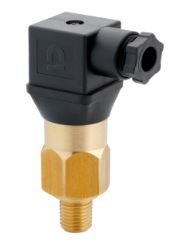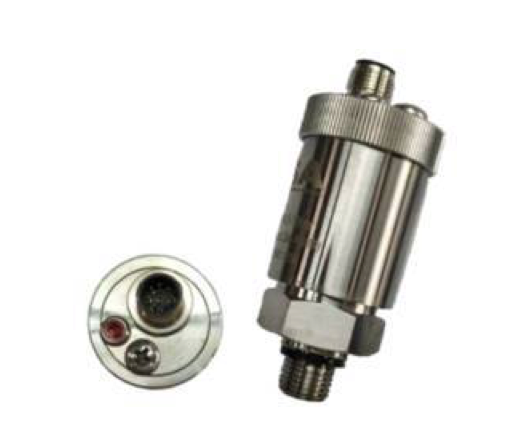Which Type of Pressure Switch Do I Need?
There are two main groups of pressure switches that are designed very differently and best fit very various applications. These are either Mechanical and Electronic pressure switches.
Here’s how pressure switch work and where best to use each one.
How Mechanical Pressure Switches Work

Directly behind the pressure switch’s process connection port is a either diaphragm, piston, or bellows chamber. The medium’s pressure deforms or moves against an end stop and the chamber acts directly onto a micro switch, or potential free contact. The setpoint can be adjusted by an adjustment screw or Allen key that repositions the microswitch within the movement range, so that it is triggered at the required pressure.Suitable Applications for Mechanical Pressure Switches
- Over or under pressure protection of hydraulic cylinders.
- Dry run pump protection .
- Fire systems.
- Mobile moving machinery
Advantages of Mechanical Pressure Switches
- Lower cost.
- Higher current ratings – can switch pumps, motors, or valves directly through the switch.
- Being a passive device, no power source is required.
Disadvantages of Mechanical Pressure Switches
- Lower longevity with a high switch rate applications.
- Not effective switching low power control signals (e.g. PLC inputs), unless gold contacts are selected.
- To set the switch point pressure, some mechanical pressure switches have the adjustment screw hidden underneath the DIN plug connector, and the set-up process is not easily carried out on site.
How electronic pressure switches work
Much like a pressure transmitter, the sensor inside the pressure switch’s port can be described as a plate that separates the media from the electronics.
On the opposite side of the plate is a transducer that converts any deflection in the plate into a measurable signal. (The definition of transducer is a device that converts one form of energy into another).
The pressure switch's components can take the form of either a resistive bridge or strain gauge type sensor, piezo effect, thin sputter film, or silicon on sapphire to name a few.
The variations are dependent on the intended application of the pressure switch, considering chemical or corrosion resistance, temperature, accuracy, cost, and pressure range.
Instead of transmitting the analogue signal as a 4-20mA or 0-10V, an electronic pressure switch uses an electronic logic comparator to compare the analogue against a trim pot (variable resistor) value and convert that result into an ON or OFF output signal, which triggers an electronic transistor output or relay.

Suitable Applications for Electronic Pressure switches
- Process control applications.
- Automation systems.
- Packaging machines.
Advantages of Electronic Pressure Switches
- Ideal for high switching rate applications.
- Setpoint adjustment easily accessed.
- High accuracy and repeatability.
Disadvantages of Electronic Pressure Switches
- Requires a power source, typically 10-30VDC.
- Higher cost than a mechanical pressure switch.
ADJUSTABLE PRESSURE SWITCHES
Both mechanical and electronic pressure switches can be either user adjustable or pre-set during manufacture.
It is convenient to have a pressure switch that is user adjustable, such as our TSA range of mechanical pressure switches.
This adjustability allows you to fine tune your pressure switch point specific to any application it helps to avoid nuisance switching. ADM stocks adjustable pressure switches, because it allows us to provide a solution for many different customers and applications.
Pre-set pressure switches offer a small price advantage. This may be an attractive option original equipment manufacturers who need pressure switches with the same set point to be supplied on a regular basis, and can plan their purchasing cycle according to the manufacturer's lead time.
Adjustable pressure switches can be set to switch at a particular pressure in the field or on the bench by using a small Allen Key or screw driver. To set this on the work bench you will need a dead-weight tester. This tester uses precision weights. A simple hydraulic system applies pressure on the port of the sensor and on a secondary, accurately calibrated, pressure gauge. Once the pressure setpoint is reached, the pressure switch is adjusted so that it either opens or closes accordingly.
Pressure Switch Contacts
Pressure switches with a built-in SPDT potential free contact relay may cost a little more, but it is worth it for the added covenience. It can function as either a normally open or normally closed switch. It is recommended that you source a pressure switch with a high voltage and current rating (like 250VAC / 5A), so that you may drive larger devices directly and without the need for an interposing relay.
Most pressure switch manufacturers offer pressure switches with gold plated switch contacts for a small charge. This is a requirement if you are switching into the digital input of a PLC or process controller. These inputs draw a very low current (< 20mA), and a standard contact often does not make a good enough electrical contact, which means the PLC will not detect the change of state.
It should be noted that if you pass more than 1 Amp through a pressure switch with gold contacts, the gold plating will burn off in time and will no longer be suitable for future use with PLC inputs.
Pay careful attention to the material that body of the pressure switch is manufactured from. First consider the chemical compatibility of the material for your application. Brass offers the best value for money with low-pressure applications, and zinc nickle plated steel for high-pressure pressure switches. Stainless steel pressure switches offer good corrosion resistance for a broad range of applications.
For mechanical pressure switches, the industruy standard DIN 43650 plug electrical plug is common, and in automation applications with electronic pressure switches an M12 connector is preferred.
Pressure switch process connections can vary depending on maximum pressures involved, and the nature of the application. However in Australia ¼" BSP Parallel seems to be the most common standard.
So many choices for such a simple device! Let ADM Instrument Engineering guide you through.
If you would like any further information on pressure switches, please do not hesitate to contact ADM Instrument Engineering.
WAS THIS INFORMATION USEFUL?
Why not share it with you industry peers on LinkedIn? Simply click on the blue LinkedIn share icon below.























